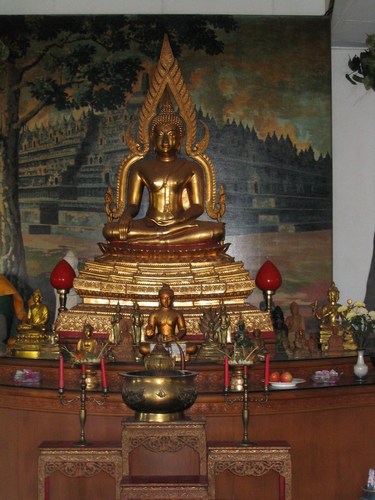Bramavihara Bhuddist Monastery: North Bali
About ten kilometres south of Lovina is the small village of Banjar to the east of Pengastulan. Nestled in the mountains is the Bramavihara Bhuddist monastery.
Driving along the steep, narrow roads and gangs that weave their way through the small villages towards the monastery was driving through the ‘real’ Bali, untouched by western influence, except of course for the odd parabola.
As I ascended a rise in the road, it was the brilliant orange-tiled roof standing out against the backdrop of a lush and deep green jungle and the colourful stupas that indicated I had arrived.
The view from the small office entrance is stunning, and I looked forward to ascending to the peak of the monastery. Wearing a sarong is obligatory and even though I had my own, there were plenty available for free as is the entrance to this complex.
Before entering the complex, I chatted with a few of the ‘keepers’ of the monastery. They told me it had been built in 1970 with the help of local labour. When it was finally completed, the complex was consecrated in 1972. I asked them who financed the building of this elaborate monastery, and apparently a majority of the finance came from the Indonesian and Thailand governments.
One of the keepers was discussing Bhuddism with Candika and I could see she was eager to enter the monastery, and so was I. We donned our sarongs.
We were stunned into silence at the beauty of the temple, perfection in construction, grass-checkered pathways and an abundance of flowering shrubs.
The entrance is guarded by two Naga statues, and there is a kulkul drum tower in the courtyard. Candika and I stopped at the first flight of steps leading to the lower temple and read the teachings of Bhudda engraves on each step before proceeding the steep climb.

Inside the lower temple, the centrepiece is a gold Bhudda statue from Thailand, and on its left there was a small collection of patung porcelain statues of the Goddess of Mercy, Dewi Welasasih. Whilst Candika prayed, I walked into the courtyard and admired the larger than life size porcelain statue of Bhudda seated in the lotus position atop a series of lotus flowers, Teratai. A large 12 foot high porcelain stupa was to the left of the Bhudda.
Again, before we ascended the second flight of steps to the higher temple, we read the teachings of Bhudda on each step. In the courtyard of the second level there is another large porcelain statue of Bhudda and Candika was quick to have her photo taken with this beautifully coloured creation.
Within the higher temple, we were in awe at yet another beautiful gold statue of Bhudda, and to each side, two relief panels portraying Bhudda speaking to his followers.

We saw one more flight of stairs. Candika looked at me and I at her, and both wondered if anything could be better than what we had just experienced. At the top of the smaller flight of stairs, we stood breathles, literally.
On the highest level standing atop beautiful grass lawns stood a miniture version of Borobudur, 30 feet high complete with 5 large stupas on top and below that a series of niches each with a Bhudda statue in various poses.
Candika and I sat for an hour absorbing the surreal atmosphere of the Borobudur re-creation, the backdrop of the jungle mountainside, and behind us, a clear view of the Bali Sea in the distance.